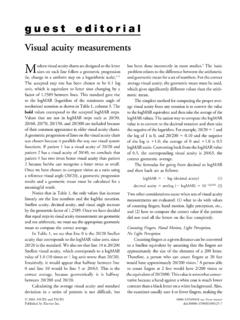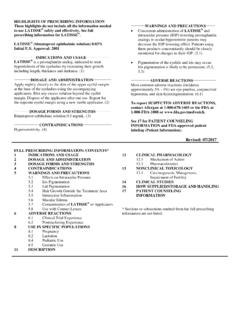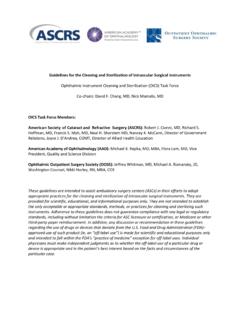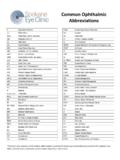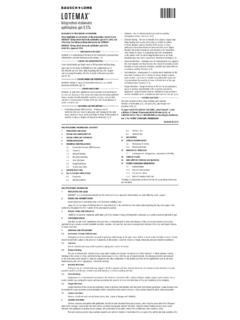Transcription of Exact Toric Intraocular Lens Calculations Using …
1 IOL), and they reduced the overall astigmatism of the eyesby correcting for astigmatism at the cornea. The accu-racy of estimating corneal plane cylinder power is ex-plored in the articles, and an alternative calculationmethod to the one used in the Alcon online Toric calcu-lator is proposed. Unfortunately, the vertex power for-mula that is given is not appropriate for converting fromthe IOL Toric power to the corneal Toric power (it wasalso originally mistyped, and the correct equation isE=F/[1 ( )F]). The basis for this equation is a calcu-lation that can be used to estimate the refractive error atthe spectacle plane if the refractive error of an eye is knownat the corneal plane. The calculation assumes that colli-mated light is initially incident on the cornea when therefraction is determined and that collimated light is alsoincident at the spectacle plane when the alternative re-fraction is calculated.
2 This equation does not correctlydescribe the imaging situation in the eye, where colli-mated light that is focused with high vergence by the cor-nea is no longer collimated at the correct calculation method is given instead by IOLpower calculation formulas,3where a power change atthe cornea can be related to a power change at the IOLusing a thin lens calculation . The Alcon online toriccalculator gives values similar to these standard calcu-lation methods, although the various formulas make dif-ferent adjustments to some of the primary parameters andthe results from different formulas are not identical. Theformulas also estimate an anterior chamber depth (ACD)value, which is the distance from the cornea to the IOLin a thin lens model of the eye, but this is not directlyequivalent to a physical distance. Goggin and col-leagues use a similar parameter for the vertex power equa-tion but appear to have used physical postoperative ACDsin the Calculations , with values measured Using IOLMas-ter, which is not approved for this inthese values may also be affecting the , the 2 articles by Goggin and colleagues dis-cuss many of the issues surrounding Calculations for toricIOLs, which are often related to the issues surroundingIOL power calculation in general.
3 Unfortunately, the useof the vertex power formula in these articles is incor-rect, and the conclusion by the authors that there is a sig-nificant error in the Alcon online Toric calculator is alsoincorrect. The clinical results are a consequence insteadof the many variables that can affect IOL power calcula-tion and astigmatic outcomes, and I look forward to ad-ditional research on this Affiliation:Alcon Laboratories, Fort Worth, :Dr Simpson, Alcon Laboratories, R3-36, 6201 S Freeway, Fort Worth, TX 76012 Disclosure:None Goggin M, Moore S, Esterman A. Outcome of Toric Intraocular lens implan-tation after adjusting for anterior chamber depth and Intraocular lens sphereequivalent power Ophthalmol. 2011;129(8) Goggin M, Moore S, Esterman A. Toric Intraocular lens outcome Using themanufacturer s prediction of corneal plane equivalent Intraocular lens cylin-der Ophthalmol.
4 2011;129(8) Retzlaff JA, Sanders DR, Kraff Implant Power ed. Thoro-fare, NJ: Slack; Zeiss. Measurement of anterior chamber depth. In:IOLM aster WithAdvanced Technology Software Release User , CA: Zeiss; Toric Intraocular lens CalculationsUsing Currently Available lens ConstantsThe article by Goggin et al1does an excellent jobexplaining that the ratio of the IOL plane cylin-der needed to neutralize the corneal plane cyl-inder in Toric IOLs cannot be a constant but must varyaccording to the effective lens position (ELP) and me-ridional powers of the Toric IOL. Failure to compensatefor these variables when selecting a Toric IOL is a signifi-cant source of error, especially in unusual , there are 2 differences in their Calculations fromthose Using standard IOL formulas (Holladay 1, SRK/T,Haigis, Hoffer Q, and Holladay 2) that make the resultsunique to their methods and do not apply to other first difference is related to the ELP.
5 The authorsused the distance from the posterior corneal vertex to theanterior vertex of the IOL (internal ACD central cor-neal thickness). The calculation for converting the mea-sured distance to the anterior vertex of the IOL to theequivalent thin lens plane was reported in cur-rently available lens constants (A-constant, ELP, Sur-geon Factor) assume an infinitely thin IOL. For the equi-convex Alcon SN60T3-9 IOL used in the study, theequivalent thin lens plane is actually posterior to the backvertex of the IOL by approximately mm. With anominal thickness of approximately mm for a 20-Dpower, the additional distance beyond the anterior ver-tex of the IOL would be mm ( ) more thanthe value used by the authors. An average value of for the postoperative ELP found by the authors vsthe manufacturer s average ELP of mm (differenceof mm) agrees very closely with the thinlens calculation .
6 Using the shorter distance results in muchlower IOL power and toricity than would be obtainedusing the higher second difference relates to the index of refrac-tion of , cited by the authors for aqueous and cor-neal tissue Using Duke-Elder and Abrams4as a refer-ence. The index of refraction for corneal tissue is used by the authors as the net index of refrac-tion is far too high. Commonly used values range to and, as reported in 2009, a value is the higher value for the net in-dex results in a higher corneal power that in turn resultsin lower IOL power and toricity than would normally beobtained with standard IOL can be seen in Table 1 in their article,1the con-stant ratio used by Alcon is (obtained by dividingthe IOL plane cylinder by the corneal plane cylinder).The authors would have found their average ratio to ( = manufacturer s ratio manufac-turer s predicted mean cylinder/authors predicted meancylinder).
7 This lower value of will work in theauthors formula but will not work in the current stan-dard IOL formulas mentioned here. This is why theMichael J. Simpson, PhDARCH OPHTHALMOL / VOL 130 (NO. 7), JULY 2012 American Medical Association. All rights From: on 08/01/2012authors could not use their formula for the actual sphe-roequivalent IOL calculation , as it would yield muchlower powers than standard IOL Calculations , resultingin significant hyperopic recently published an article with a table that givesthe ratios for IOL cylinder to corneal cylinder for vari-ous ELPs and spheroequivalent powers of an IOL with a spheroequivalent power of 34 D and anELP of mm, a low ratio of is obtained (very nearthe authors ratio of with an ELP of mm). Fora spheroequivalent power of 10 D and an ELP of mm,a high ratio of is obtained. For a 22-D IOL and anELP of mm, a ratio of is obtained, which is veryclose to the manufacturer s ratio of The companycould not have been as far from the mean constant valueas suggested ( vs , respectively) or they wouldnot have been able to receive approval by the US Foodand Drug Administration.
8 However, it must be empha-sized that the more unusual the actual patient values are,the larger the error made by Using a constant ratio only Exact commercial calculators available at thistime are the Abbott Medical Optics Express Calculatorand the Holladay IOL Consultant Program7for which Iwrote the algorithms a few years ago. It is also possibleto solve for the toricity and Exact axis of the IOL fromthe postoperative refraction and postoperative keratom-etry so that one can determine the Exact amount of ro-tation necessary to minimize the residual astigmatism ifthe IOL is misaligned. This solution is somewhat morecomplicated because it involves another intermediatecross-cylinder calculation when the IOL axis is not alignedwith the steepest meridian of the cornea. I thank the au-thors for making this extremely important clinical ob-servation and hope that these comments explaining thedifference between their results and those Using stan-dard IOL formulas are helpful.
9 It does not minimize theimportance of their valuable Affiliation:Department of Ophthalmology, Bay-lor College of Medicine, Houston, :Dr Holladay, PO Box 717, Bellaire, TX77402-0717 Disclosure:Dr Holladay is the author of theHolladay IOL Consultant Program and a consultant toAbbott Medical Goggin M, Moore S, Esterman A. Toric Intraocular lens outcome Using themanufacturer s prediction of corneal plane equivalent Intraocular lens cylin-der Ophthalmol. 2011;129(8) Holladay JT. Standardizing constants for ultrasonic biometry, keratometry,and Intraocular lens power Cataract Refract Surg. 1997;23(9) Holladay JT, Maverick KJ. Relationship of the actual thick Intraocular lensoptic to the thin lens J Ophthalmol. 1998;126(3) Duke-Elder S, Abrams D. Optics. In: Duke-Elder S, of Ophthalmol-ogy: Ophthalmic Optics and 5. London, England: Henry Kimp-ton; 1970 Holladay JT, Hill WE, Steinmueller A.
10 Corneal power measurements usingscheimpflug imaging in eyes with prior corneal refractive RefractSurg. 2009;25(10) Holladay JT. Improving Toric IOL Surgery News. Published May 25 and June 10, September 28, Holladay JT. Holladay IOL Consultant and Surgical Outcomes Accessed September 28, Intraocular lens CalculationsGoggin et al1should be commended for their in-teresting analysis of the conversion from the IOLto the corneal plane of the cylinder of toriclenses, as to our knowledge no one else has focused theattention on such a relevant topic. However, some im-portant issues must be Using the example of the SN60T3 IOL in theintroduction, the authors confused thin lens and thicklens formulas. They calculated the equivalent cylinderat the corneal plane Using the manufacturer s effectivelens position of mm. By means of the thick lens ver-tex power formula, they obtained values of D D, respectively, for the and IOLs, com-pared with the nominal value provided by themanufacturer.
